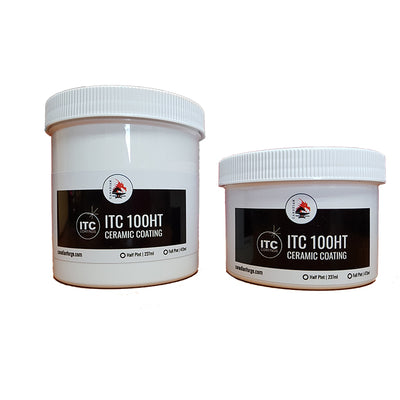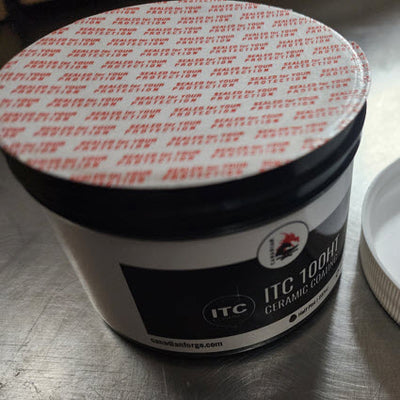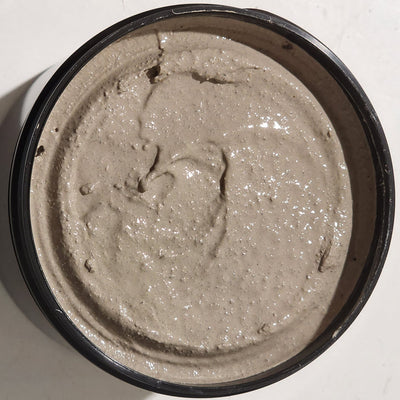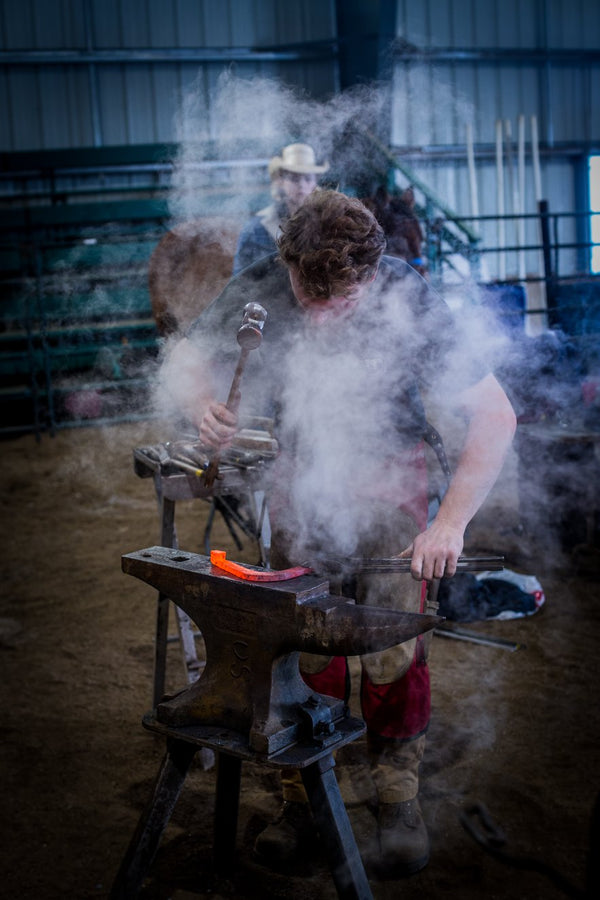Our ITC100 HT is a Reflective Ceramic Coating rated to 5000°F.
Increase your efficiency by up to 40%. Save fuel, faster heats, safer surroundings, protects other refractories from heat, oxidation, abrasion, and flux.
ITC can be applied to any refractory's heat face to optimize heat reflection and minimize heat migration. It seals porous surfaces for efficiency and safety.
SPECIAL: All ITC-100 from Canadian Forge comes with a complimentary:
a) a sealable mixing container large enough to add 50% water & mix,
b) a small recycled rag as an option to apply the ITC (or a stiff brush).
c) an industrial 24" x 16" sheet of folded wax paper for a tidy work area.
Use ITC-100 to coat the hot side of Insulating Firebricks, Hard Firebricks, Ceramic Wool, and Insulating or Dense Castables.
(Metaphorically, ITC 100 does to a propane forge what a turbocharger does to a diesel motor - it's like free power and efficiency.)
ITC can be applied directly to ceramic wool (rigidized), but for optimal performance, durability and economy, my preference is to apply a thin reflective coat of ITC as the finish coat. This can be the only coating on a brick. Wool is optimally first rigidized and coated with a quality insulating castable (ie: Kast-O-Lite 30 Li+) first. (**favourite practice). When you want a thinner wool 'skin-coat', use 'DRAGON Skin, ALIEN Skin, or a combination.
ITC-100's 5000°F rating is nearly double the theoretical maximum propane forge temperature (without supplying extra oxygen), and the ~40% efficiency gain can approximate tremendous efficiency and fuel savings.
Less heat conduction through the walls of a forge minimizes thermal stress expansion shock, helping preserve the build materials, mitigating cracks, warping, and refractory fatigue.
Health Benefits of ITC 100:
- Ceramic wool heated above its rating limit aerosolizes tiny microfibers that, once inhaled, behave like asbestos in your lungs.
- 2200°F wool can cost 3x less than 2600°F, look indistinguishable, and permanently seed your lungs with permanent dust at normal forging heats.
- Worse, wool's temperature ratings are only for momentary peak temperatures; the constant temp ratings are 150°F lower! (Rule of thumb: 2450°F propane forge = 2600°F wool.)
- A) Never skimp on lower-temperature ceramic wool than you need.
- B) Encapsulate the wool with an Insulating Castable to seal and protect it.
- C) Coat the castable with a reflective coating of ITC-100. This can reduce the insulation temperatures by hundreds of degrees over fractions of an inch.
New generation Bio-absorbable wool will soon become stable at forge heats and at affordable prices, but until then don't mistake saving $40 on wool at the cost of breathing for 40 more years.
Though commonly sought after for its efficiency and refractory protection, by sealing and reflecting the fireside of wool insulation, ITC's protective benefit on your forge is trumped only by the health benefit it extends to you.
Application:
1. Reconstitute with water. Mix ITC 100 with 50% water prior to application. **TIPS:
A) Only mix the ITC you think you'll use today (Its shelf life is longer before water).
B) Keep unused ITC well sealed and cool.
2. Mist with water first.Penetration is best when surfaces are first very lightly misted with water. This helps the ITC wick deeper into the wool, brick, or castable.
3. Apply with a thin cotton rag or a stiff or cut-off paintbrush.The consistency is more similar to runny toothpaste than paint. It can be poured with a small 'watering-can'- type device in open horizontal applications. Otherwise, it's best applied using a paintbrush with bristles cut short to stiffen them. (It can also be sprayed with an air gun in larger applications.)
4. Rigidize the wool first.Before applying a castable (like RescoCast 8) or ITC 100 to a Ceramic Wool Blanket, it is best to rigidize the wool first. (Standard & Freeze Proof Rigidizer). **Fire the rigidizer to 'crystalize it' on the wool. It makes it easier to coat, and you won't compress it.
5. If damaged, reapply as a patch. If the ITC-coated surface becomes damaged, another 'patch' coating can simply be applied as needed.
6. Have ITC left over?For longer-term storage, wrap the lid with electrical tape to prevent evaporation. Mix before and during use. Dried out? Try adding a little water overnight.
HOW MUCH DO I NEED?
Coverage depends on the level of porosity/absorbency of the material that you're applying it to.
FULL PINT (473 ml) Jar.
- Fiber Lining Coverage est: 5 sq ft.
- Insulating Brick Lining Coverage est: 10 sq ft.
- Brick Lining or Hardcast Refractory Coverage est: 6.25 to 12.5 sq ft.
HALF PINT (237 ml) Jar.
- Fiber Lining Coverage est: 2.5 sq ft
- Insulating Brick Lining Coverage est: 5 sq ft
- Brick Lining or Hardcast Refractory Coverage est: 3.13 to 6.25 sq ft
Click here for ITC 100 HT SDS, ITC 100 HT Technical Data Sheet, and ITC 100 HT Application Guide.
Winter Shipping: Click here for more details on winter shipping protocols.
ITC Coated Products -ITC-100 is now available applied & pre-baked on:
- - Split Bricks (Hard Bricks) 0.5", 0.9", & 1.25" thick (as sacrificial floor bricks)
- - 6" Round Floor Pedestal Bricks (1-1.25" thick) /keep crucibles off the floor
- - IFB (Insulated Fire Bricks) coated 1, 5 or 6 sides 2300, 2400/2500 or 2600
- - Custom Refractory Castings both cast and ITC coated























